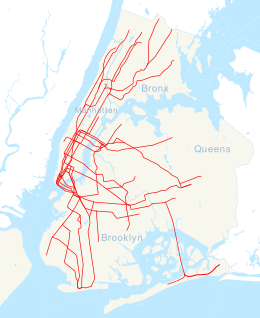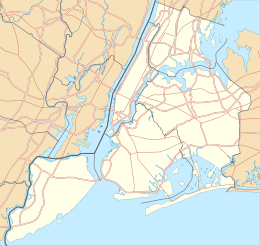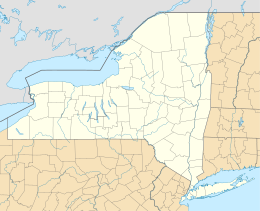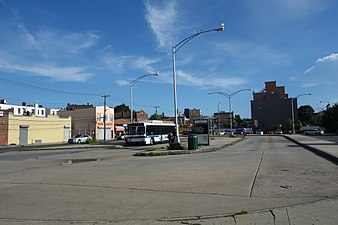railroad.wikisort.org - Station
The Far Rockaway–Mott Avenue station (announced as Far Rockaway station) is the eastern terminal station of the New York City Subway's IND Rockaway Line. Originally a Long Island Rail Road station, it is currently the easternmost station in the New York City Subway. It is served by the A train at all times.
Far Rockaway–Mott Avenue | ||||||||||||||||||||||||||||||||||||||||||||||||||||||||||||||||||||||||||||||||||
|---|---|---|---|---|---|---|---|---|---|---|---|---|---|---|---|---|---|---|---|---|---|---|---|---|---|---|---|---|---|---|---|---|---|---|---|---|---|---|---|---|---|---|---|---|---|---|---|---|---|---|---|---|---|---|---|---|---|---|---|---|---|---|---|---|---|---|---|---|---|---|---|---|---|---|---|---|---|---|---|---|---|---|
 | ||||||||||||||||||||||||||||||||||||||||||||||||||||||||||||||||||||||||||||||||||
| Station statistics | ||||||||||||||||||||||||||||||||||||||||||||||||||||||||||||||||||||||||||||||||||
| Address | Mott Avenue & Beach 22nd Street Queens, NY 11691 | |||||||||||||||||||||||||||||||||||||||||||||||||||||||||||||||||||||||||||||||||
| Borough | Queens | |||||||||||||||||||||||||||||||||||||||||||||||||||||||||||||||||||||||||||||||||
| Locale | Far Rockaway | |||||||||||||||||||||||||||||||||||||||||||||||||||||||||||||||||||||||||||||||||
| Coordinates | 40.603983°N 73.755426°W | |||||||||||||||||||||||||||||||||||||||||||||||||||||||||||||||||||||||||||||||||
| Division | B (IND, formerly LIRR Far Rockaway Branch)[1] | |||||||||||||||||||||||||||||||||||||||||||||||||||||||||||||||||||||||||||||||||
| Line | IND Rockaway Line | |||||||||||||||||||||||||||||||||||||||||||||||||||||||||||||||||||||||||||||||||
| Services | A | |||||||||||||||||||||||||||||||||||||||||||||||||||||||||||||||||||||||||||||||||
| Transit | ||||||||||||||||||||||||||||||||||||||||||||||||||||||||||||||||||||||||||||||||||
| Structure | Elevated | |||||||||||||||||||||||||||||||||||||||||||||||||||||||||||||||||||||||||||||||||
| Platforms | 1 island platform | |||||||||||||||||||||||||||||||||||||||||||||||||||||||||||||||||||||||||||||||||
| Tracks | 2 | |||||||||||||||||||||||||||||||||||||||||||||||||||||||||||||||||||||||||||||||||
| Other information | ||||||||||||||||||||||||||||||||||||||||||||||||||||||||||||||||||||||||||||||||||
| Opened | July 29, 1869 (SSRRLI, then LIRR station)[2] | |||||||||||||||||||||||||||||||||||||||||||||||||||||||||||||||||||||||||||||||||
| Rebuilt | July 15, 1890, January 16, 1958 (as a subway station)[3] | |||||||||||||||||||||||||||||||||||||||||||||||||||||||||||||||||||||||||||||||||
| Accessible | ||||||||||||||||||||||||||||||||||||||||||||||||||||||||||||||||||||||||||||||||||
| Opposite- direction transfer | N/A | |||||||||||||||||||||||||||||||||||||||||||||||||||||||||||||||||||||||||||||||||
| Traffic | ||||||||||||||||||||||||||||||||||||||||||||||||||||||||||||||||||||||||||||||||||
| 2019 | 1,347,765[4] | |||||||||||||||||||||||||||||||||||||||||||||||||||||||||||||||||||||||||||||||||
| Rank | 317 out of 424[4] | |||||||||||||||||||||||||||||||||||||||||||||||||||||||||||||||||||||||||||||||||
| ||||||||||||||||||||||||||||||||||||||||||||||||||||||||||||||||||||||||||||||||||
| ||||||||||||||||||||||||||||||||||||||||||||||||||||||||||||||||||||||||||||||||||
| ||||||||||||||||||||||||||||||||||||||||||||||||||||||||||||||||||||||||||||||||||
| ||||||||||||||||||||||||||||||||||||||||||||||||||||||||||||||||||||||||||||||||||
| ||||||||||||||||||||||||||||||||||||||||||||||||||||||||||||||||||||||||||||||||||
| ||||||||||||||||||||||||||||||||||||||||||||||||||||||||||||||||||||||||||||||||||
As of 2016[update], this station is the busiest of all subway stations in the Rockaway peninsula. The original surface station on this site was opened in 1869; the current elevated station began operation as a subway station on January 16, 1958. The station was renovated between 2009 and 2012.
History
LIRR use
The Far Rockaway Branch of the Long Island Rail Road had originally been part of a loop that traveled along the existing route. The line diverges from the present-day Atlantic and Long Beach Branches east of Valley Stream station in Valley Stream, New York. Eastbound trains continued south then southwest, through Five Towns and the Rockaway Peninsula, and onto a trestle across Jamaica Bay through Queens where it reconnected with the Rockaway Beach Branch; westbound trains did the reverse, using the Rockaway Beach Branch to cross the trestle, go through the Rockaways and Five Towns, and continue northeast then north to join the westbound Atlantic Branch.[5][6]
Far Rockaway station itself was originally built by the Far Rockaway Branch Railroad, a subsidiary of the South Side Railroad of Long Island. Construction on the line began in September 1868, and the station was opened on July 29, 1869.[5][6] The station was later converted into a freight house, when a second station was moved from Ocean Point Station (a.k.a. Cedarhurst Station), remodeled, and opened on October 1, 1881. The third depot opened on July 15, 1890, while the second depot was sold and moved to a private location in October 1890. The surface station featured a large plaza and depot, serving horse-drawn carriages, taxis, and surface trolleys.[5][7] The Ocean Electric Railway terminated at the station between 1897 and September 2, 1926, and the station served as the headquarters for the Ocean Electric Railway.[8][9]
The station also served as the terminus of a Long Island Electric Railway trolley line leading to Jamaica, via New York Avenue (now Guy R. Brewer Boulevard). Following the end of trolley service in November 1933,[10] the depot served buses from Green Bus Lines and Jamaica Buses;[5][7][10] the former Jamaica trolley route became Jamaica Buses' Route B (now the Q113 and Q114 buses).[10][11] Around noon on April 10, 1942, the surface station was closed, and a new elevated station on the current concrete trestle was opened as part of the Long Island Rail Road's grade crossing elimination project.[12][13] This station had two low-level side platforms.[14]
Subway use

There were frequent fires and maintenance problems on the Jamaica Bay viaduct. The most notorious of these problems was a fire in May 1950 between The Raunt and Broad Channel Stations.[15] After this fire, the LIRR abandoned the Jamaica Bay viaduct and the Queens portion of the Rockaway Beach/Far Rockaway route. On June 11, 1952, the city acquired all trackage west of Mott Avenue, incorporating it as part of the IND Rockaway Line.[16] Service provided by the A train over the line began in June 1956, with the full western spur to Rockaway Park operational.[15] While the remainder of the line operated, with Beach 25th Street–Wavecrest serving as the eastern spur terminal,[15] a new Far Rockaway subway station was constructed, opening on January 16, 1958.[17][18][19][20]
The Far Rockaway LIRR station was moved to a grade-level station at Nameoke Street on February 21, 1958—two blocks from the original station and three blocks from the subway station—becoming the terminus of the Far Rockaway branch.[5][14][21][22] The original site of the LIRR's elevated station and the bus depot, located on the northeast side of Mott Avenue, were replaced with a shopping center and parking lot,[5][21][22][23] which began construction in 1960.[24] The Far Rockaway Shopping Center, as it was called, started undergoing redevelopment in 2017 as part of the Far Rockaway rezoning; it was proposed to replace the shopping center with affordable housing.[25][26]
In 1981, the MTA listed the Mott Avenue station among the 69 most deteriorated stations in the subway system, despite the fact that the station had become part of the subway system just two decades earlier.[27] From 2009 to 2012, this and eight other stations were renovated for $117 million. At Far Rockaway, the 1950s design of the station house was replaced with metallic facades and a dome enclosure, and upgrading several features including staircases and employee areas. Elevators from the station house to the platforms were added, as were yellow tactile warning strips on the platform edges, making the station ADA-accessible. A glass artwork titled Respite was installed as part of the MTA's Arts for Transit program. The renovated station was unveiled on May 11, 2012.[17][28][29]
Disputed age
Far Rockaway is the oldest currently operating New York City Subway station, having originally opened 153 years ago, on July 29, 1869, as a Long Island Rail Road station. By contrast, the Gates Avenue station on the BMT Jamaica Line in Brooklyn is the oldest station to have been built specifically for rapid transit use, having opened in 1885 (137 years ago). The Gates Avenue station is also the oldest continuously operating station in the subway system.[30] The Far Rockaway station was converted from LIRR to subway loading gauges in 1958 and has only operated for 64 years in this capacity.[18][31] Therefore, by that interpretation, Far Rockaway is actually the fifteenth newest station in the subway system (behind Grand Street;[32] Harlem–148th Street;[33] 57th Street;[31] the three Archer Avenue Line stations;[34] the three IND 63rd Street Line stations;[35] the new South Ferry station;[36] 34th Street–Hudson Yards;[37] and the three Second Avenue Subway stations[38]).
Station layout
| P Platform level |
Northbound | ← |
| Island platform | ||
| Northbound | ← | |
| G | Street level | Exits/entrances |
| Station building | Lobby, fare control, station agent | |
The Far Rockaway–Mott Avenue station, the Rockaway Line's eastern terminus, is built on a concrete viaduct and has two tracks and an island platform. The tracks end at bumper blocks just beyond the northeast end of the platform.[39] The former track connection to the current LIRR's Far Rockaway station has been removed, and transferring now requires a walk of three blocks.[21] A NYCDOT municipal parking facility lies just east of the station between Beach 22nd and Beach 21st Streets, adjacent to the bus loop used by the Q22, QM17 and n33 services that terminate at the station.[40][41]
The doors at the northeast end of the platform lead to stairs down to the street level fare control area. A tower and crew offices are at the southwest end. Two elevators and several staircases inside the station house lead to the platform level.[17] A bodega called the "A Line Deli", previously called the "Last Stop Deli", is attached to the station entrance. It was originally a cafe, having been built along with the station in the 1950s.[42][43]
- Jason Rohlf's Respite piece in the station
- On the platform
- Jay Walder, then-chairman of the MTA, greets Hurricane Irene evacuees
- The bus terminal and parking lot adjacent to the station
References
- "Glossary". Second Avenue Subway Supplemental Draft Environmental Impact Statement (SDEIS) (PDF). Vol. 1. Metropolitan Transportation Authority. March 4, 2003. pp. 1–2. Archived from the original (PDF) on February 26, 2021. Retrieved January 1, 2021.
- Vincent F. Seyfried, The Long Island Rail Road: A Comprehensive History, Part One: South Side R.R. of L.I., © 1961
- New York City Transit. "New York City Transit - History and Chronology". Archived from the original on October 19, 2002. Retrieved January 10, 2007.
- "Facts and Figures: Annual Subway Ridership 2014–2019". Metropolitan Transportation Authority. 2020. Retrieved May 26, 2020.
- Lucev, Emil (June 18, 2010). "Historical Views of the Rockaways: The old Far Rockaway Station Plaza, Mott and Central Avenues, 1922". The Wave. Archived from the original on July 1, 2015. Retrieved June 29, 2015.
- "A Fire Watch Transportation". Wave of Long Island. Fultonhistory.com. December 13, 1973. p. 6. Archived from the original on May 20, 2022. Retrieved August 17, 2016.
- Lucev, Emil (October 8, 2010). "Historical Views of the Rockaways: The LIRR Depot and Plaza Far Rockaway, New York ... 1912". The Wave. Archived from the original on July 1, 2015. Retrieved June 29, 2015.
- Meyers, S.L. (2006). Lost Trolleys of Queens and Long Island. Images of Rail. Arcadia Publishing. pp. 139–140. ISBN 978-1-4396-3386-1. Archived from the original on February 3, 2017. Retrieved July 16, 2016.
- "OCEAN ELECTRIC RAILROAD". LONG ISLAND RAIL ROAD HISTORY, Online Museum of Long Island Rail Road and Photo Gallery. Archived from the original on October 16, 2011. Retrieved July 16, 2016.
- "Jamaica Buses To Inaugurate New Service: Ceremony Will Be Held Tomorrow in Opening Routes to Southeast". The Brooklyn Daily Eagle. November 10, 1933. Archived from the original on October 2, 2018. Retrieved October 13, 2015.
- Soto, Juan (August 29, 2014). "New Q114 bus line ready for first riders". Times Ledger. Archived from the original on September 26, 2015. Retrieved October 12, 2015.
- "Last Grade Crossing In Rockaways Ends" (PDF). The New York Times. April 11, 1942. Archived from the original on May 20, 2022. Retrieved June 30, 2015.
- "Pushes Grade Separation" (PDF). The New York Times. January 24, 1932. Archived from the original on May 20, 2022. Retrieved June 30, 2015.
- Linder, Bernard (February 2006). "Rockaway Line". New York Division Bulletin. Electric Railroader's Association. 49 (2): 3–4. Archived from the original on February 2, 2017. Retrieved August 27, 2016.
- Freeman, Ira Henry (June 28, 1956). "Rockaway Trains to Operate Today" (PDF). The New York Times. Archived from the original on May 20, 2022. Retrieved June 29, 2015.
- "Fifty Years of Subway Service to the Rockaways". New York Division Bulletin. New York Division, Electric Railroaders' Association. 49 (6). June 2006. Archived from the original on October 22, 2016. Retrieved August 31, 2016 – via Issu.
- "Far Rockaway-Mott Av. Station Rehabilitation Now Complete: Rockaway A Line Station Now ADA Compliant". mta.info. Metropolitan Transportation Authority. May 11, 2012. Archived from the original on December 26, 2015. Retrieved June 29, 2015.
- "New Subway Unit Ready: Far Rockaway IND Terminal Will Be Opened Today" (PDF). The New York Times. January 16, 1958. Archived from the original on May 20, 2022. Retrieved June 29, 2015.
- "New Station Set At Howard Beach" (PDF). The New York Times. November 11, 1954. Archived from the original on May 20, 2022. Retrieved June 29, 2015.
- "Far Rockaway Subway Station: Transit Authority Advances On Rockaway Frontier". Wave of Long Island. Fultonhistory.com. October 24, 1957. p. 1. Archived from the original on May 20, 2022. Retrieved July 22, 2016.
- "Shop Center Due in Far Rockaway: Market and Big Parking Lot to Replace L.I. Station Being Moved 2 Blocks" (PDF). The New York Times. July 6, 1956. Archived from the original on May 20, 2022. Retrieved June 29, 2015.
- "Far Rockaway To Have $3 Million Shopping Center". Wave of Long Island. August 1, 1957. p. 1. Archived from the original on May 20, 2022. Retrieved July 22, 2016 – via Newspapers.com.
- "L.I.R.R. to Shift Station" (PDF). The New York Times. April 5, 1957. Archived from the original on May 20, 2022. Retrieved June 29, 2015.
- "Shopping Center Construction To Get Under Way In September". Wave of Long Island. Fultonhistory.com. May 12, 1960. p. 1. Archived from the original on May 20, 2022. Retrieved July 22, 2016.
- "Housing planned for blighted Queens shopping center". am New York. March 6, 2018. Archived from the original on November 12, 2018. Retrieved November 12, 2018.
- "New Life for Old Far Rockaway Shopping Center". Rockaway Times. October 25, 2018. Archived from the original on November 12, 2018. Retrieved November 12, 2018.
- Gargan, Edward A. (June 11, 1981). "Agency Lists Its 69 Most Deteriorated Subway Stations". The New York Times. Archived from the original on March 31, 2019. Retrieved August 13, 2016.
- Rosenberg, Miriam (May 18, 2012). "Ribbon Cut On A Train Station". The Wave. Archived from the original on July 1, 2015. Retrieved June 29, 2015.
- "Mott Avenue Subway Renovations Taking Shape". The Wave. May 6, 2011. Archived from the original on July 1, 2015. Retrieved June 29, 2015.
- Dembart, Lee (September 9, 1977). "A Sentimental Journey on the BMT..." (PDF). The New York Times. Archived from the original on May 20, 2022. Retrieved July 2, 2015.
- Raskin, Joseph B. (2013). The Routes Not Taken: A Trip Through New York City's Unbuilt Subway System. New York, New York: Fordham University Press. doi:10.5422/fordham/9780823253692.001.0001. ISBN 978-0-82325-369-2.
- Perlmutter, Emanuel (November 16, 1967). "Subway Changes to Speed Service: Major Alterations in Maps, Routes and Signs Will Take Effect Nov. 26" (PDF). The New York Times. Archived from the original on October 30, 2021. Retrieved July 7, 2015.
- "IRT Passengers Get New 148th St. Station". The New York Times. May 14, 1968. p. 95. Archived from the original on December 21, 2021. Retrieved October 4, 2011.
- Johnson, Kirk (December 9, 1988). "Big Changes For Subways Are to Begin". The New York Times. Archived from the original on March 8, 2021. Retrieved July 14, 2015.
- Kennedy, Randy (May 25, 2001). "Panel Approves New V Train but Shortens G Line to Make Room". The New York Times. Archived from the original on November 26, 2010. Retrieved March 20, 2010.
- NY1 News (March 9, 2009). "South Ferry Station To Open Next Week". NY1. Archived from the original on March 11, 2009. Retrieved September 26, 2015.
- Fitzsimmons, Emma G.; Schweber, Nate (September 13, 2015). "Subway Station for 7 Line Opens on Far West Side". The New York Times. Archived from the original on September 14, 2015. Retrieved September 26, 2015.
- Fitzsimmons, Emma G.; Wolfe, Jonathan (January 1, 2017). "Second Avenue Subway Opening: What to Know". The New York Times. Archived from the original on January 1, 2017. Retrieved January 1, 2017.
- Cox, Jeremiah. "Far Rockaway-Mott Avenue (A) - The SubwayNut". www.subwaynut.com. Archived from the original on July 6, 2020. Retrieved January 2, 2017.
- "Municipal Parking Facilities". New York City Department of Transportation. Archived from the original on May 3, 2021. Retrieved August 16, 2016.
- "MTA Bus Time: Q22 Rockaway Beach Blvd - Beach Channel Dr". mta.info. MTA Bus Time. Archived from the original on November 7, 2015. Retrieved August 16, 2016.
- Newman, Andy (August 22, 2008). "The Curious World of the Last Stop". The New York Times. Archived from the original on February 25, 2015. Retrieved December 12, 2010.
- New York City Transit Authority (June 12, 1958). "Restaurant Attached to Far Rockaway Station: IND Rockaway Line". New York Transit Museum. Archived from the original on August 28, 2016. Retrieved August 25, 2016.
External links
- nycsubway.org – IND Rockaway: Mott Avenue/Far Rockaway
- Station Reporter — A Rockaway
- The Subway Nut — Far Rockaway – Mott Avenue Pictures
- Trains Are Fun — Former Far Rockaway LIRR Station
- Mott Avenue entrance from Google Maps Street View
- Platform from Google Maps Street View
На других языках
- [en] Far Rockaway–Mott Avenue station
[ru] Фар-Рокавей — Мотт-авеню (линия Рокавей, Ай-эн-ди)
«Фар-Рокавей — Мотт-авеню» (англ. Far Rockaway–Mott Avenue) — станция Нью-Йоркского метрополитена, расположенная на линии Рокавей, Ай-эн-ди. Станция находится в Квинсе, в округе Фар-Рокавей (полуостров Рокавей), на пересечении Бич 22-й улицы и Мотт-авеню. На станции останавливается маршрут A (круглосуточно). Станция является южной конечной для него. Оба пути заканчиваются тупиками: поезд приходит на любой из путей и отправляется обратно. Станция является самой восточной в метрополитене.Другой контент может иметь иную лицензию. Перед использованием материалов сайта WikiSort.org внимательно изучите правила лицензирования конкретных элементов наполнения сайта.
WikiSort.org - проект по пересортировке и дополнению контента Википедии







